#elizabeth r 1971
Explore tagged Tumblr posts
Text
ELIZABETH R (1971)
ELIZABETH R
1971
Elizabeth R is a historic television 6-part series which stars Glenda Jackson as Elizabeth I of England. It was filmed at Penshurst Place and Chiddingstone, Kent. The TV series begins in 1549, with Princess Elizabeth’s ascent to the throne and ends with her death in 1603. It was so popular when it was first broadcast that they had to replay it immediately afterwards due to audience demand. The series was created after the success of the TV series the ‘Six Wives of Henry VIII’ (1970). Glenda Jackson played Elizabeth I once again for the Mary Queen of Scots (1971). Costume designer Elizabeth Waller recreated many of Elizabeth’s actual gowns, adapting them from her portraits. The dresses went on display at Hampton Court Palace.
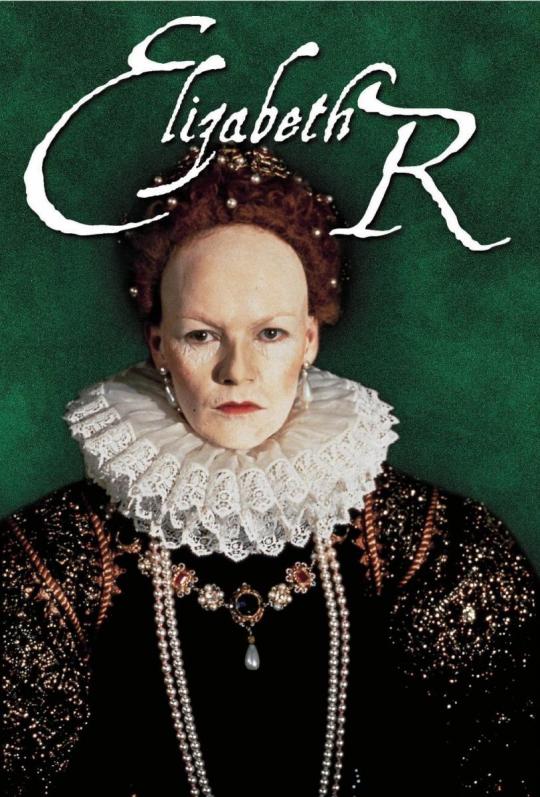
#elizabethr #elizabethr1971 #glendajackson #elizabethiofengland
0 notes
Text


Period dramas dresses tournament: Black dresses Round 1- Group B: Elizabeth I, Elizabeth R (pics set) vs Elizabeth I, Mary queen of Scots
#period drama dresses tournament#tournament poll#tumblr tournament#polls#fashion poll#elizabeth tudor#elizabeth i#elizabeth r#mary queen of scots#mary queen of scots 1971#black r1
70 notes
·
View notes
Text
Ranking Men's Costumes in Period Dramas - Part II: The Good
Part I: The Bad
This is the second part to my ranking of men's costumes in Renaissance period dramas. I selected 10 shows and films which I think have great costuming for the female characters and ranked them according to their costumes for male characters. I have noticed that even when women's costuming is great, men's costuming might be absolutely dog shit. And that's very much what we saw in the first part, where I ranked the five worst entries. For some reason shows and movies are afraid to put men, especially the characters who are supposed to be cool, manly and hot, into historical costumes. And I'm not even asking for historical accuracy, I just don't want my male characters living in the actual 1500s in basically modern leather jackets and pants. Like I don't watch period dramas for vaguely historically inspired modern fashion, I watch it for the historical setting, which costumes help create. This time we will be looking some rare gems that actually imo have really good costuming even for the male characters. For the five best entries, we'll go from worst to best.
5. Eizabeth R (1971)
Elizabeth R is incredibly committed to historical accuracy in it's outfits, especially for queen Elizabeth herself, many of her costumes being directly recreated from her portraits. It covers the whole reign of Elizabeth, so this commitment is especially admirable as the timeline is more than 40 years, including a stark shift in fashion from less structured and more toned down Tudor fashion to the extremes of the highly structured Elizabethan fashion. It's not perfect, The hair is not always great and like many others they fail at French hoods, though they are not upward pointing or pseudo crowns detached from the hood, so could be much worse.

The men's costumes are also very good. They are faithful to history, they wear stockings, very short trunk hose, ruffs and even have some structuring in their doublets and jerkins. However, the reason this is not higher is that the men's costumes especially, but also many other costumes beside Elizabeth's are looking a little sloppy. There's some structure yes, but the men's silhouettes are just not bold enough and they end up looking a little costumy. Even the codpieces are shrunk so small I'm not even sure if they are there half the time. Cowardice. Here's two Robert Dudley's costumes and an actual portrait of him. I think the second costume is probably an attempt at recreation of that portrait, but it's just kinda halfway there.
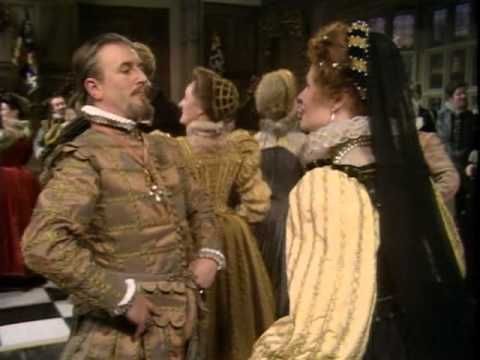
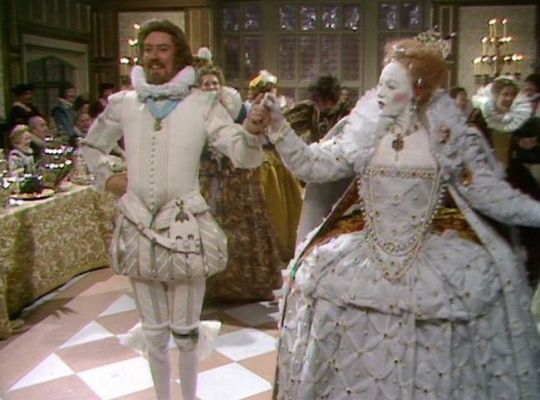
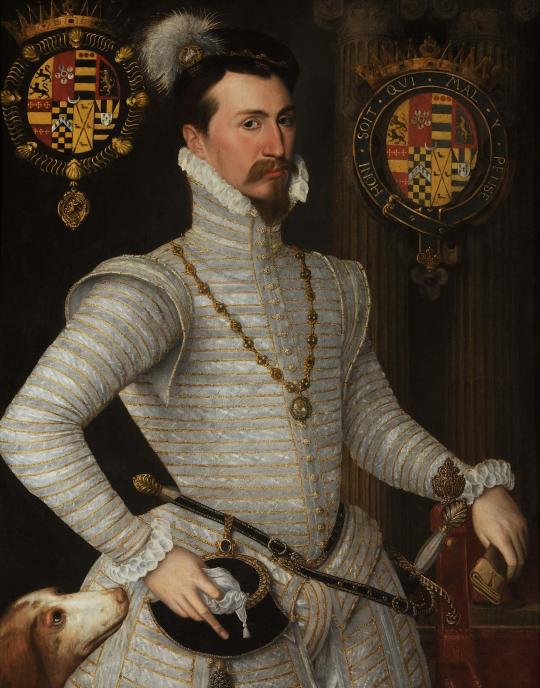
4. Taming of the Shrew (1967)
This film is set in Renaissance Italy, the women's costumes fit well to 1520s-30s. They are honestly really great and cohesive. My only gripe is that their bodices have a very 1960s shape and the make-up is a little distractingly modern. But the costuming is not attempting to recreate historical accuracy, rather they took the historical silhouette and basic elements and crafted a very over the top but cohesive look. I honestly love these very much.
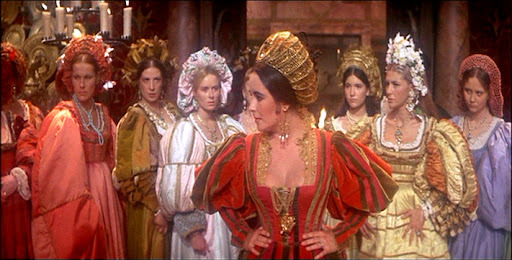


An interesting choice is made with the men's costuming, especially the main male lead, whose costume is based much more on the Renaissance German men's fashion of that period. His costumes resemble the over the top fashion of the German Landsknecht (first image below). In Italy (second image below) the doublets were also very voluminous and quite colourful but not to that extent as by the Landsknecht and literally no one, not even the other Germans, rocked that slashed style as hard.
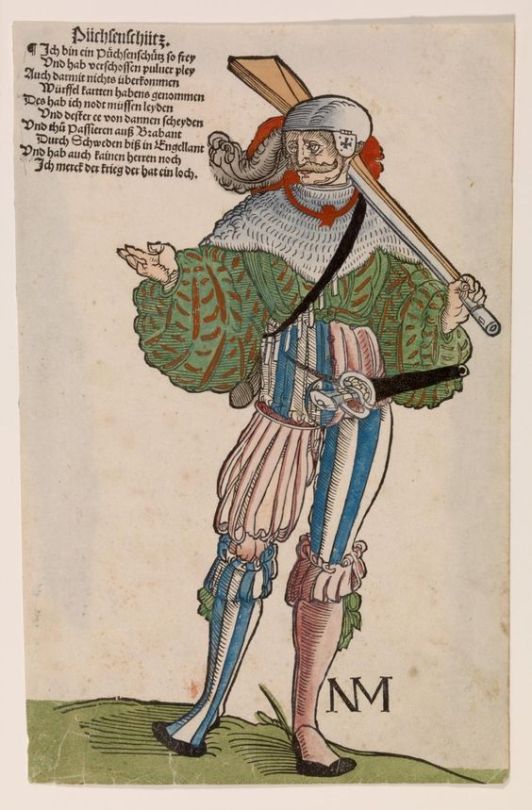

This is not really criticism though. In fact I respect that choice a lot. His costumes are certainly not historically accurate, but they do fit the bombastic aesthetics of the overall costuming, they are loud, large and not afraid to fuck around. This man oozes sex-appeal much more than any character with some modern plain black pants and leather jacket. This is how you costume a Renaissance man who fucks.
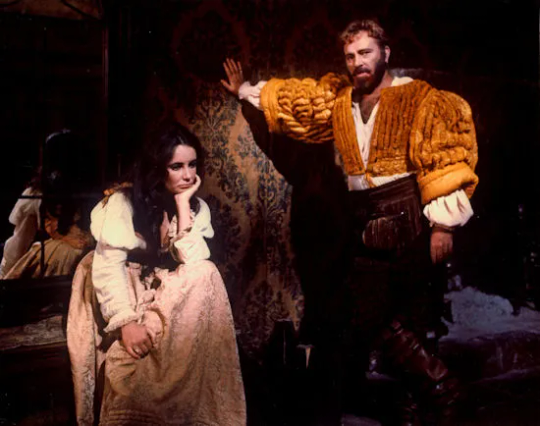
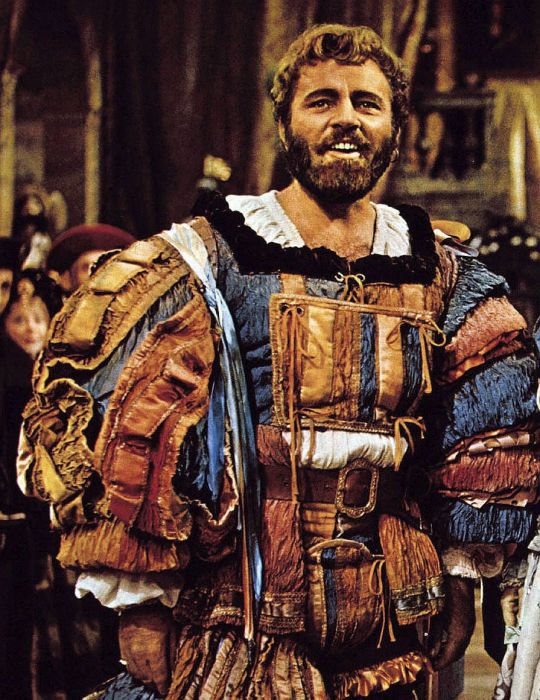
3. Tulip Fever (2017)
I am stretching the definition or Renaissance here a bit, I admit. This movie is set during the 1630s tulip mania, by which point the remnants of Renaissance fashion had already been left to the previous decade. However, I do think most of the movies and TV set in Baroque era also struggle with the men's costumes. Though not as much, because black was fashionable for everyone, the cod piece was gone, trunk hose were replaced by more palatable Venetian hose, fashion was much more stripped down from embellishments, leather was not uncommon in jerkins and appeared even in doublets and hose and the Hollywood's beloved boots became actual fashion items. The men's silhouette in this period is very silly in my opinion and people seem to agree because it's usually skipped in costuming, but overall the period seems to fit modern masculinity standards much more easily than Renaissance era.
But I just really wanted to include this because the costuming is absolutely stunning (and let's be honest we are a bit desperate here trying to find 5 actually good examples). I have not watched the movie and probably never will because the post production was an absolute mess and it apparently came out as just a very bad movie, which is a shame, since the costumes are so good. The ruffs are perfectly crispy. The buttons are dense and look just right. The shoes, both boots and otherwise are so on point. The fabrics are honestly perfect. The silhouettes are just as goofy as they are supposed to be. And the women too have perfect silhouettes. All the details are just simply perfect. You rarely find costuming this meticulously created with historical details and great construction.
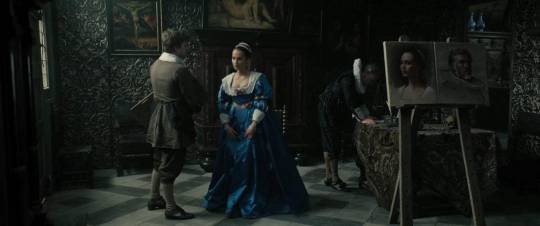
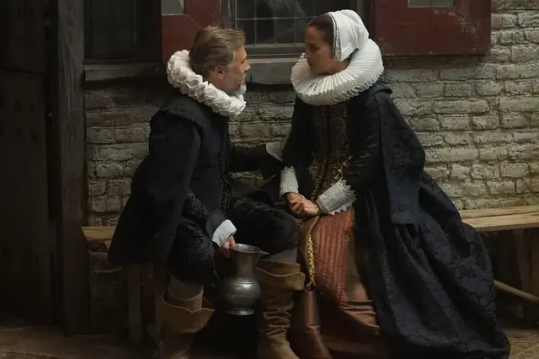
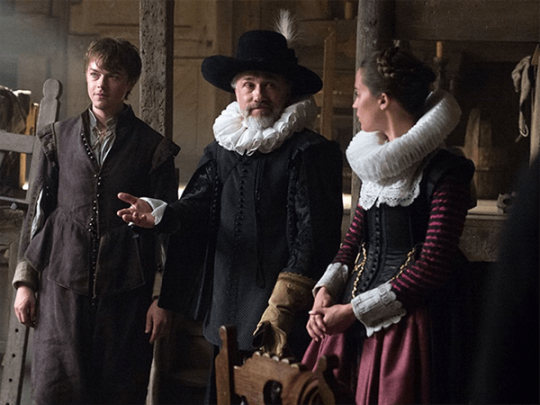
Honestly these top three could all be the best one. This final order was decided purely on which costumes I like more. And while I love the women's fashion of this period, I think the men's fashion is kinda stupid and boring, so I don't like these costumes on aesthetic level as much as the top two.
2. Romeo and Juliet (1968)
This movie is a perfect counterpart to the movie with the worst men's costuming which I talked about in the first post, Rosaline. They are both set in Italy around very end of 15th century and retell Romeo and Juliet. Both have very good costuming for female characters but obviously I think differ greatly in the male character costuming department. Romeo and Juliet costuming takes some artistic liberties to create a heightened reality quite similar to Taming of the Shrew costuming, but follows history much more closely. The colors are bright, the hose are tight, the giorneas are voluminous, the sleeves are long and massive and the cod pieces are prominent. Even the hair is perfect, even for women, they even use hairnets. I imagine the men's hair was quite easy to get right as hairstyles in 60s and 70s were basically lifted directly from 1400s Italian men's hairstyles. The men are even wearing appropriate goofy hats??? Amazing.


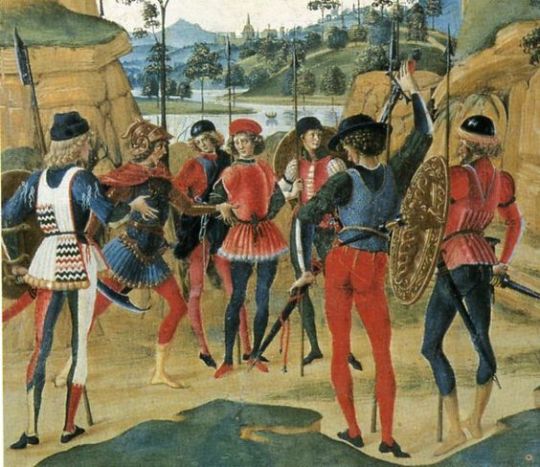
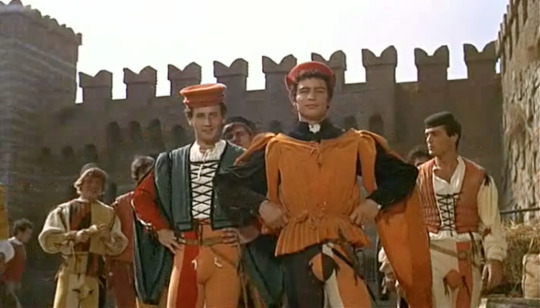
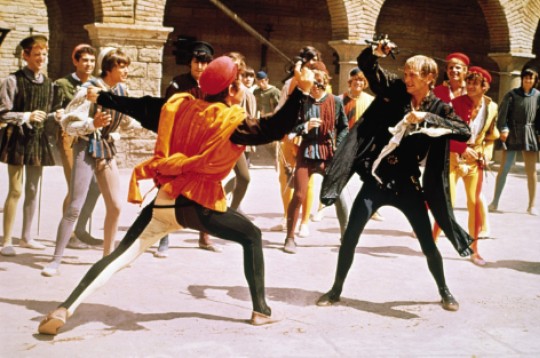
The costuming perfectly captures the era, but they still clearly had fun with it too. Honestly even though I appreciate the meticulously recreated historically accurate costuming, like in Tulip Fever, I tend to like more costuming that does take some artistic liberties to create a distinct look and atmosphere for the movie or TV show. There's some small things they don't get quite right, like having standard lacing instead of ladder lacing, metal eyelets (which would become a thing as late as in 1830s) and most egregiously Juliet in one scene has this very dumb supportive undergarment without even shift under it (first picture below)?? The outer garments were supportive during this era, there was no such thing as supportive undergarment which was any different from the outer kirtle (or gamurra in Italy). Shift was the only truly undergarment. But I will forgive these errors because the costuming is overall so fun and gorgeous. And they did get some details so so right, like look at Romeo's arming doublet (second picture below)! It has Lombardian sleeves!! This was a very specific style of arming doublet for this era and place. However those errors does prevent it from taking the first place. Which leads us to...


1. Orlando (1992)
This movie has Tilda Swinton in flamboyant Elizabethan men's clothing. That's all.


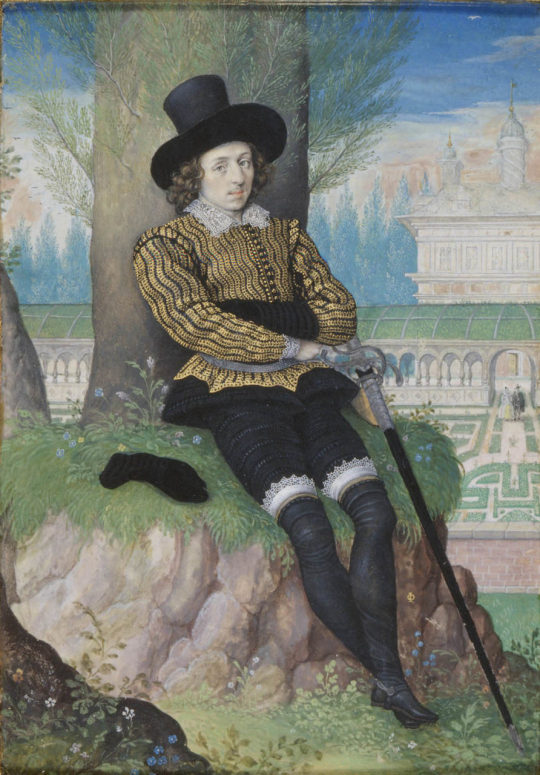


Okay, I that is all that needs to be said, but I will say more. This movie spans centuries and shows excellent costumes from several different periods, but I will focus on the Elizabethan costumes only for the sake of this post. The costuming is not super historically accurate in all the detailing, and clearly not trying to be, but it is always impeccable. Even while it takes artistic liberties and the story has an immortality fantastical element it still captures the men's fashion's silhouette much better than any other movie or TV show I know of set in this period. It does that better than the "we recreated these portraits" Elizabeth R. But what really makes this the best in my humble opinion, is that the movie is not afraid of the effeminate and emasculated modern perception of Renaissance men's fashion, no, it leans into it and uses it to explore the themes. The whole story is very much about gender and gender fuckery. Tilda Swinton plays the titular Orlando who is a cis man in Elizabethan era, becomes inexplicably immortal and later inexplicably turns into a woman for the rest of their several centuries. He is the embodiment of "I'm not sure if they are a butch or a twink" and as a bisexual I can only be grateful. But in all seriousness I think the costuming and the casting (queen Elizabeth is also played by a male actor) are so perfectly utilized to highlight the arbitrary construction of gender without needing to say it explicitly.
Conclusion
I have some closing thoughts. I took on this task as a way to show a point, which is that for some reason in Renaissance shows and film especially men's costuming is piss-poor, even when women's costuming is great. Male characters tend to have very bad costuming in Medieval media too, though this is also an issue for female characters. I don't think I have ever seen a Medieval show or movie with truly excellent costuming for anyone. In Renaissance media the issue is clearly not lack of skill or knowledge, they choose to do so. My thesis was that the producers think that the Renaissance men's fashion is too effeminate and too unsexy for the Hot Very Heterosexual Male Lead, who the mostly female audience are supposed fawn over like the female characters do. After the analysis think my hypothesis holds up.
Though there's an interesting trend I only noticed while doing this ranking; every entry (except the least bad) in the worst five list are from 21th century, and every entry (except Tulip Fever which is a little bit cheating anyway) in this best five list are from 20th century. I have some theories on why it turned out this way. First is that the studios have become increasingly more concerned with growing profits so they don't take risks and they put pressure on movies and TV shows to be as broadly appealing as possible. This means they can't just make period dramas for the core audience of period dramas, aka mostly women who are history nerds, so they pander to the modern sensibilities in costuming and not to the people who love to see actual historical costuming. Secondly, I think this might also tie to the broader conservative backlash against loosening of gender roles and broader queer acceptance. Among the core audiences of period dramas there are two distinct groups, queer nerds and conservative women, who don't want politics in their media, which is why they love historical stories because obviously queerness wasn't invented yet and people of colour didn't exist yet (they were and did). (They are ofc not always this extreme, but you get the point.) As men wearing dresses has become a culture war issue, I think the studio executives are afraid that anything not masculine enough in modern standards might alienate the more conservative audiences, and more broadly those who don't want to feel like they are engaging with modern political culture war topics in their escapist media. Even if they knew about the queer nerds, they wouldn't care about them and assume they will go along with it anyway. After all not challenging modern gender roles is not seen as an active choice, it's the default.
This bears repeating: cowards.
As a thank you for reading all the way to the end I will leave you with the image of Tilda Swinton in mid 1600s men's clothing. You are welcome.
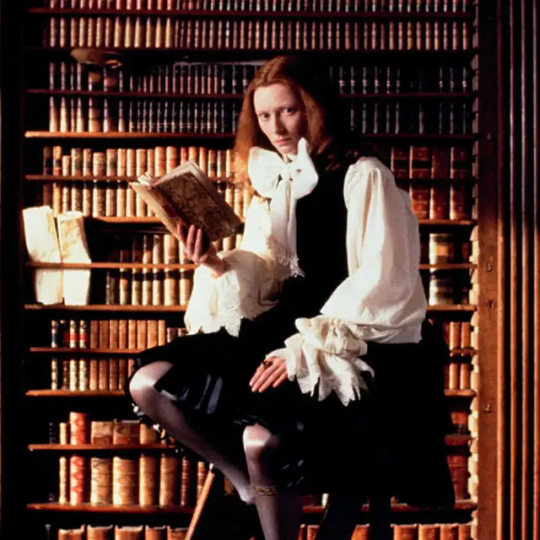
Part I: The Bad
#fashion history#history#historical costuming#costuming#renaissance fashion#renaissance costuming#film costuming#historical men's fashion
192 notes
·
View notes
Text



Top, L-R: Rosalie Crutchley as Catherine Parr in The Six Wives of Henry VIII (1970), Episode 6: Catherine Parr (written by John Prebble)
Bottom: Rosalie Crutchley as Catherine Parr in Elizabeth R (1971), Episode 1: The Lion's Cub (written by Rosemary Anne Sisson)
edited by me
#tudor era#the six wives of henry viii 1970#elizabeth r#catherine parr#katherine parr#rosalie crutchley#perioddramaedit#tudorerasource#dailytudors#was this a good Parr depiction?#ehhhhhh#it gets across her piety and learning#but very little else#there's very little sense of spirit#crutchley is the personification of sobriety in TSWOH8 1970#i mean she marries thomas seymour at the end not bc she's in love w him#but to protect henry's kids from unscrupulous counselors i -#her Protestant zeal is rly only accentuated by her sober and steady behavior#like i found it entertaining after a bit#just bc of how overly serious and religious they made her#but i'm not sure it does the real KP much justice
96 notes
·
View notes
Text

Daphne Slater as Queen Mary I of England (Elizabeth R, 1971)
100 notes
·
View notes
Text








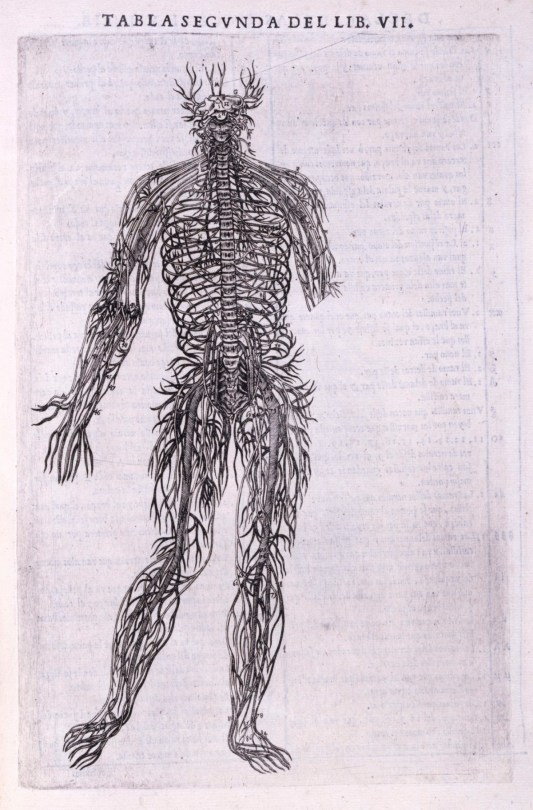



The Nervous System
Nervous System. Illustration by Leveille for Wonders of the Human Body by A Le Pileur (1871). // The Nervous System. Illustration for The Body and Health: Grade Six edited by Ruby Simpson and Elizabeth Smith (1936).
[In the womb we watch our eyelids. This is enough] lines 1-6. By Rosalie Moffett from her collection Nervous System (2019).
Flight (Nerves). By Kate Klingbeil as a part of the Nervous System series (2023). // A purkinje neuron from the human cerebellum. Santiago Ramon y Cajal (1899).
Nervous system of Harriet Cole. Dr. R. B. Weaver (1898) // Illustration from Modern Biology by Truman J. Moon, Paul B. Mann, and James H. Otto (1947).
[After great pain a formal feeling comes] line 2. Emily Dickinson (ca. 1862).
Nervous system of the human body. Attributed to Gaspar Becerra from the book De humani corporis fabrica libri septem by Andreas Vesalius (ca. 1556). // Illustration from Tashrih-i Mansur-I [Mansur's Anatomy] by Mansur ibn Muhammad ibn Ahmad ibn Yusuf ibn Ilyas (ca. 1390).
Illustration from Use Your Brain written by Paul Showers and illustrated by Rosalind Fry (1971). // Nervous System. Jean-Michel Basquiat (1982).
17 notes
·
View notes
Text
Fouke Monster
the Fouke Monster also known as the Boggy Creek Monster and the Swamp Stalker, is purported to be an ape-like creature, similar to descriptions of Bigfoot, that was allegedly sighted in the rural town of Fouke, Arkansas during the early 1970s. The creature was alleged to have attacked a local family.

The creature was named by journalist Jim Powell, who reported on it for the Texarkana Gazette and the Texarkana Daily News.
Various reports between 1971 and 1974 described it as being a large, bipedal creature covered in long dark hair. It was estimated to be about 7 feet (2 m) tall with a weight of 250–300 pounds (110–140 kg). Later reports claimed that it was far larger, with one witness describing it as 10 feet (3 m) tall, with an estimated weight of 800 pounds (360 kg). Some accounts describe the Fouke Monster as running swiftly with a galloping gait and swinging its arms in a fashion similar to a monkey. Reports also describe it as having a terrible odor, the odor being described as a combination of a skunk and a wet dog, and as having bright red eyes about the size of silver dollars.
A variety of tracks and claw marks have been discovered which are claimed to belong to the creature. One set of foot prints reportedly measured 17 inches (43 cm) in length and 7 inches (18 cm) wide, while another appeared to show feet that only possessed three toes.
Prior to the 20th century, several alleged sightings in the general area related to a large, hairy creature circulated in an 1851 report in the Memphis Enquirer, and an 1856 report in the Caddo Gazette.
Local residents claim that the creature had roamed the area since 1964, but those sightings had not been reported. Local folklore also holds that the creature can be further traced back to sightings in 1946. Most early sightings were allegedly in the region of Jonesville as the creature was known as the "Jonesville Monster" during this period.
In 1955 the creature was allegedly spotted by a 14-year-old boy who described it as having reddish brown hair, sniffing the air, and not reacting when it was fired upon with birdshot. Investigator Joe Nickell observed that the description was consistent with a misidentified black bear (Ursus americanus).
The Fouke Monster first made local headlines in 1971, when it was reported to have attacked the home of Bobby and Elizabeth Ford on May 2, 1971.
According to Elizabeth Ford, the creature, which she initially thought was a bear, reached through a screen window that night while she was sleeping on a couch. It was chased away by her husband and his brother Don. During the alleged encounter, the Fords fired several gun shots at the creature and believed that they had hit it, though no traces of blood were found. An extensive search of the area failed to locate the creature, but three-toed footprints were found close to the house, as well as scratch marks on the porch and damage to a window and the house's siding. According to the Fords, they had heard something moving around outside late at night several nights prior but, having lived in the house for less than a week, had never encountered the creature before.
The creature was allegedly sighted again on May 23, 1971, when three people, D. C. Woods, Jr., Wilma Woods, and Mrs. R. H. Sedgass, reported seeing an ape-like creature crossing U.S. Highway 71.[19] More sightings reports were made over the following months by local residents and tourists, who found additional footprints. The best known footprints were found in a soybean field belonging to local filling station owner Scott Keith. They were scrutinized by game warden Carl Galyon, who was unable to confirm their authenticity. Like the Ford prints, they appeared to indicate that the creature had only three toes.
The incident began to attract substantial interest after news spread about the Ford sighting. The Little Rock, Arkansas, radio station KAAY posted a $1,090 bounty on the creature. Several attempts were made to track the creature with dogs, but they were unable to follow its scent. When hunters began to take interest in the Fouke Monster, Miller County Sheriff Leslie Greer was forced to put a temporary "no guns" policy in place in order to preserve public safety. In 1971, three people were fined $59 each "for filing a fraudulent monster report."
After an initial surge of attention, public interest in the creature decreased until it gained national recognition in 1973 when Charles B. Pierce released a docudrama horror film about the creature in 1972, The Legend of Boggy Creek.
By late 1974, interest had waned again and sightings all but stopped; only to begin again in March 1978 when tracks were reportedly found by two brothers prospecting in Russellville, Arkansas. There were also sightings in Center Ridge, Arkansas. On June 26 of that same year, a sighting was reported in Crossett, Arkansas. During this period the creature was blamed for missing livestock and attacks on several dogs.
Since the initial clusters of sightings during the 1970s, there have been sporadic reports of the creature. In 1991, the creature was reportedly seen jumping from a bridge. There were forty reported sightings in 1997 and, in 1998, the creature was reportedly sighted in a dry creek bed 5 miles (8 km) south of Fouke.
34 notes
·
View notes
Text

12/21: the hanged man
derived from:
The Encyclopedia of Tarot; Stuart R. Kaplan; 1978; Page 225 & 259
The Night Country; Loren Eiseley, Illustrated Leanord Everette Fisher; 1971; Page 170 & 194
National Geographic; October 1976 Issue; Miscellaneous Ads
Volcano Weather: The Story of 1816, The Year Without a Summer; Henry and Elizabeth Stommel; 1983; Page xii
45 notes
·
View notes
Text
The Morgan Library & Museum
Crafting the Ballets Russes
The Robert Owen Lehman Collection

Crafting the Ballets Russes: The Robert Owen Lehman Collection
June 28 through September 22, 2024
Robert Owen Lehman’s extraordinary collection of music manuscripts has been an inspiration to scholars and visitors since it was placed on deposit at the Morgan Library & Museum. Among its many splendid works are deep holdings of early-twentieth-century ballet, including Igor Stravinsky’s Firebird (1910), Petrouchka (1911), and Les Noces (1923); Claude Debussy’s L’après-midi d’un Faune (1912); and Maurice Ravel’s Bolero (1928) and La Valse (1920).
The exhibition opens with the dramatic arrival of Serge Diaghilev’s Ballets Russes troupe in Paris in 1909 and goes on to trace its impact across the arts, highlighting the rise of women in leading creative roles. They include Bronislava Nijinska, who in 1921 became the Ballets Russes’ only female choreographer and whose groundbreaking choreography defined Les Noces, Bolero, and other ballets of the era; and Ida Rubinstein, whose riveting stage presence helped establish the Ballets Russes in its first seasons and who came to rival Diaghilev as a patron of music, commissioning Bolero in 1928.
At the core of the exhibition is the creative process that brought these ballets to life. The exhibition and accompanying catalogue address the sketches, drafts, and working copies of the composers, choreographers, and designers, capturing the ways in which they imagined, conceived, and collaborated to kindle works of astonishing originality and ongoing influence.
The exhibition is organized by Robinson McClellan, Assistant Curator of Music Manuscripts and Printed Music.
Crafting the Ballets Russes: The Robert Owen Lehman Collection is supported by the William Randolph Hearst Fund for Scholarly Research and Exhibitions, the Robert Lehman Foundation, Mr. and Mrs. Clement C. Moore II, the Lucy Ricciardi Family Exhibition Fund, Elizabeth and Jean-Marie Eveillard, Cynthia Hazen Polsky and Leon Polsky, and the Franklin Jasper Walls Lecture Fund. Assistance is provided by the Gladys Krieble Delmas Foundation and Hubert and Mireille Goldschmidt.
(L) Igor Stravinsky (1882–1971), Firebird, autograph manuscript, piano, extensive revisions, [1910]. The Morgan Library & Museum, New York, Robert Owen Lehman Collection, on deposit. Used by kind permission of European American Music Distributors Company, sole U.S. and Canadian agent for Schott Music GmbH & Co. KG, Mainz, Germany, publisher and copyright owner.
(R) Léon Bakst (1866–1924), “Firebird and the Prince (Tsarevitch),” poster design for Firebird, 1915. Harvard Theatre Collection, Houghton Library, Howard D. Rothschild Collection.



#. The Morgan Library & Museum, New York #art #original art #xpuigc
10 notes
·
View notes
Text
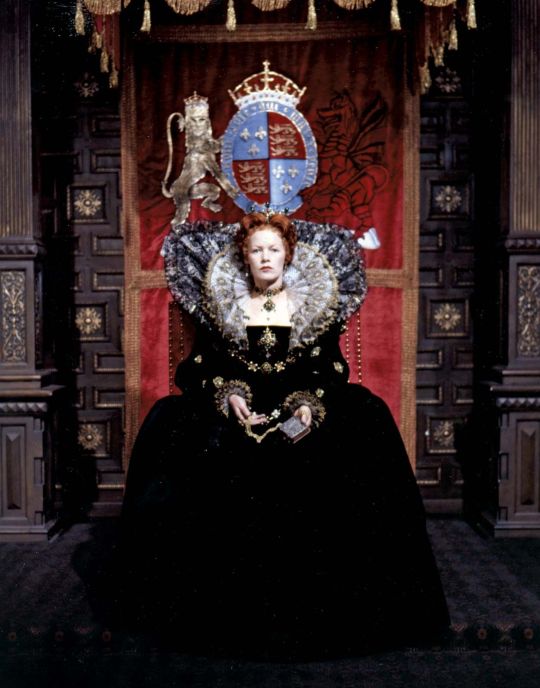
Oscar, Tony, and Emmy-winning actor and Labour MP Glenda Jackson, famed for her extraordinary portrayal of Elizabeth I in both Elizabeth R and Mary, Queen of Scots (1971), passed away yesterday (15 June 2023) at 87.
#on this day#badass ladies#tudors#the video is a mid-2000s fan compilation that has since been taken down#but that I watched so many times I could recreate it from memory#I've posted this before but I've cleaned it up for the occasion
31 notes
·
View notes
Text
I'm currently watching the 1971 Sense & Sensibility on YT and having issues that only the approx. 2 other Poldark 1975 fans on here will understand.
I knew Robin Ellis was in it (he and Joanna David being the two main reasons I was so keen to see it). I'd just assumed he was Willoughby - it's 1971, the year he played Essex in Elizabeth R and if you want dashing, handsome but definitely trouble in the early 70s he's yr man.
AND THEN HE TURNED UP AS EDWARD FERRARS.
Who, I asked, curious, could be Willoughby, then?
... and then Clive Francis walked in and my brain exploded.
#sense and sensibility#i mean#it's fine#i just am wondering how the director cast both of them that way round???#they're both good they'll be fine#and joanna david/robin ellis is an amazingly attractive 1970s pairing#but still. clive francis would have had a field day with the geeky comic aspect of edward and willoughby is robin ellis's type#and yet this director looked at them both and somehow cast them and put them that way round?#(the only truly inexplicable casting tho is that baffling thing old tv does sometimes#where being at all plump apparently = 20 years older than you actually are. patricia routledge is amazing but she won't#be old enough for mrs jennings yet for at least 10 years. what. old tv. what.)#(i am enjoying it. they just imploded my 1970s poldark loving brain and i'm not sure i'm ok)#old brit tv problems... XD#1970s#poldark 1975#robin ellis#clive francis
13 notes
·
View notes
Text
Birthdays 8.4
Beer Birthdays
Julius Deglow (1823)
William J. Seib (1836)
Rod DeWitt (1957)
Aaron Mateychuk (1965)
Five Favorite Birthdays
Louis Armstrong; jazz trumpeter, bandleader, actor (1901)
Richard Belzer; comedian, actor (1944)
Greta Gerwig; actress (1983)
Barack Obama; 44th U.S. President (1961)
William Schuman; composer (1910)
Famous Birthdays
Aleksandr Danilovich Aleksandrov; Russian mathematician, physicist, and mountaineer (1912)
Warren Avis; businessman (1915)
Béla Balázs; Hungarian poet (1844)
David Bedford; English keyboard player (1937)
George Irving Bell; physicist, biologist, and mountaineer (1926)
Henri Berger; German composer (1844)
Roger Clemens; Boston Red Sox P (1962)
Allison Hedge Coke; American-Canadian poet (1958)
Robbin Crosby; guitarist and songwriter (1959)
Gerard Damiano; film director (1928)
Don S. Davis; actor (1942)
Mary Decker; track and field athlete (1958)
Lorenzo di Pierfrancesco de' Medici; Florentine patron of the arts (1463)
Michel Déon; French novelist, playwright (1919)
Queen Elizabeth The Queen Mother of the UK (1900)
Herb Ellis; jazz guitarist (1921)
Frankie Ford; R&B/rock & roll singer (1939)
Witold Gombrowicz; Polish author and playwright (1904)
Jeff Gordon; race car driver (1971)
William Rowan Hamilton; Irish physicist, astronomer, and mathematician (1805)
Knut Hamsun; Norwegian writer (1859)
Robert Hayden; poet (1913)
Martin Jarvis; English actor (1941)
Cleon Jones; New York Mets LF (1942)
Johann Gottlob Lehmann; German mineralogist and geologist (1719)
Leopold I, Duke of Austria (1290)
Helen Kane; singer and actress (1904)
Lee Mack; English comedian, actor (1968)
Meghan Markle; actress (1981)
Ernesto Maserati; Italian race car driver and engineer (1898)
Paul McCarthy; painter and sculptor (1945)
John Newton; composer of “Amazing Grace” (1725)
Walter Pater; English author (1839)
Clara Peller; “Where’s the Beef” lady (1902)
David Raksin; composer (1912)
Paul Reynolds; English singer-songwriter and guitarist (1962)
Bernard Rose; English film director (1960)
Klaus Schulze; German keyboard player and songwriter (1947)
Percy Bysshe Shelley; English poet (1792)
Helen Thomas; journalist (1920)
Billy Bob Thornton; actor (1955)
John Henry Twachtman; painter (1853)
John Venn; English mathematician and philosopher (1834)
Louis Vuitton; French fashion designer (1821)
Raoul Wallenberg; Swedish humanitarian (1912)
Tim Winton; Australian author (1960)
Isoroku Yamamoto; Japanese admiral (1884)
2 notes
·
View notes
Text


See pinned post for the full bracket!
2 notes
·
View notes
Photo
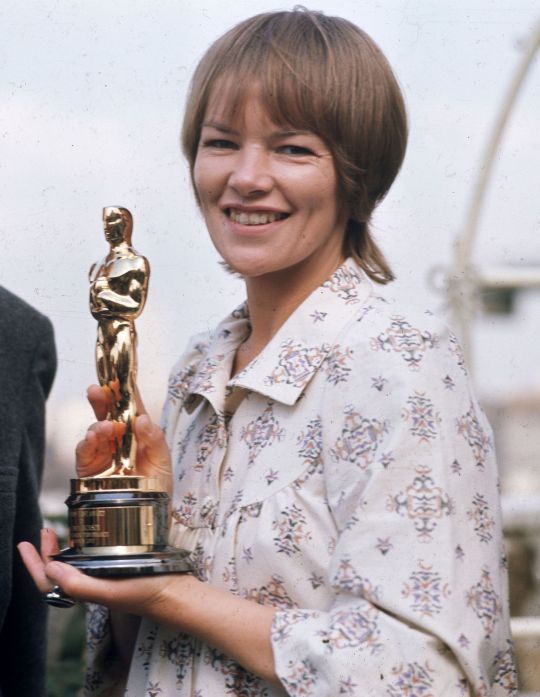
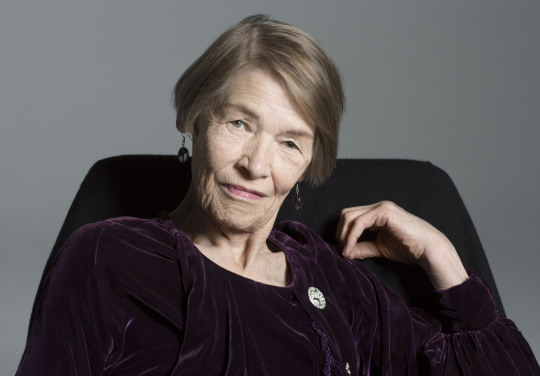
GLENDA JACKSON (1936-Died June 15th 2023,at 87).English actress and politician. She was one of the few artists to achieve the Triple Crown of Acting, having won two Academy Awards, three Emmy Awards and a Tony Award. She was made a CBE by Queen Elizabeth II in 1978.She won the Academy Award for Best Actress twice: for her roles in Women in Love (1970) and A Touch of Class (1973), not appearing in person to collect either of her Oscars due to work commitments.She won the BAFTA Award for Best Actress in a Leading Role for Sunday Bloody Sunday (1971). Her other notable roles include Mary, Queen of Scots (1971), Hedda (1975), The Incredible Sarah (1976) and Hopscotch (1980). She won two Primetime Emmy Awards for her role as Elizabeth I in the BBC series Elizabeth R (1971). She received the British Academy Television Award for Best Actress for her role in Elizabeth Is Missing (2019). Jackson took a hiatus from acting to take on a career in politics from 1992 to 2015, and was elected as the Labour Party MP for Hampstead and Highgate in the 1992 general election. She served as a junior transport minister from 1997 to 1999 during the government of Tony Blair, later becoming critical of Blair. After constituency boundary changes, she represented Hampstead and Kilburn from 2010. At the 2010 general election, her majority of 42 votes, confirmed after a recount, was the narrowest of that parliament.Jackson stood down at the 2015 general election and returned to acting. https://en.wikipedia.org/wiki/Glenda_Jackson
#Glenda Jackson#British Actresses#Actresses#English Actresses#British Politicians#Politicians#Elizabeth R#Women in Love#A Touch of Class#Notable Deaths in June 2023#Notable Deaths in 2023
5 notes
·
View notes
Text




Vivian Pickles as Mary, Queen of Scots in Elizabeth R (1971)
1st pic (top, left) - Vivian Pickles as Mary in Episode 2, The Marriage Game (written by Rosemary Anne Sisson)
2nd-4th pics - Vivian Pickles as Mary in Episode 4, Horrible Conspiracies (written by Hugh Whitemore)
edited by me
#tudor era#perioddramaedit#tudorerasource#mary queen of scots#vivian pickles#elizabeth r#i do love this portrayal of MQOS#partly bc she's one of the only depictions to show her as middle aged#at her execution as she was IRL#but also bc the script uses a lot of her IRL words when she defends herself in the Babington Plot#nearly all of which are a pack of desperate lies#idk i'm not a fan of historical MQOS#and this MQOS is outclassed by Elizabeth at nearly every turn which#a harsh but not unjustified portrayal
53 notes
·
View notes
Text
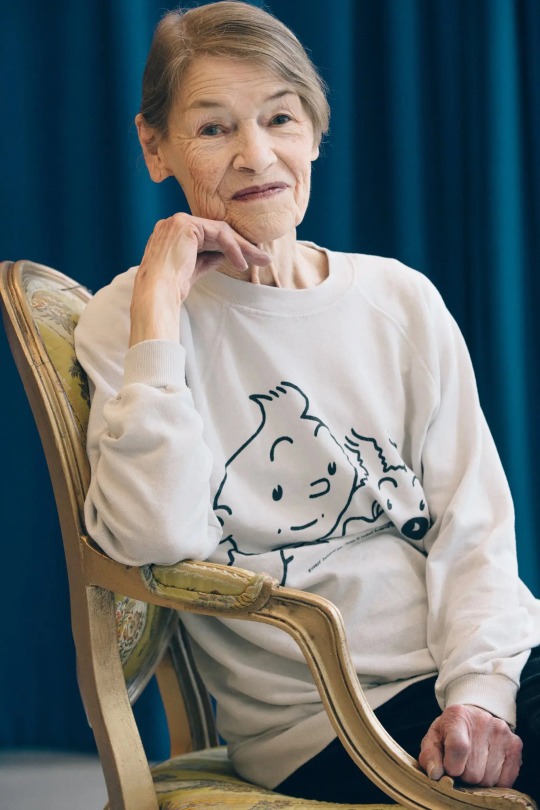
Glenda Jackson has died at the age of 87 after “a brief illness” at her home in London.
In a statement, her agent, Lionel Larner, said: “Glenda Jackson, two-time Academy Award-winning actress and politician, died peacefully at her home in Blackheath, London, this morning after a brief illness with her family at her side.”
Jackson bestrode the narrow worlds of stage and screen like a colossus over six decades. Though such a Shakespearean tribute would undoubtedly have had the famously curmudgeonly actor reaching for her familiar catchphrase: “Oh, come on. Good God, no,” nothing less will do for a star who emerged from a 23-year career break to play King Lear at the age of 82.
Not only did she win an Evening Standard theatre award for that performance, but she brought the audience to its feet by playing up to her ferocious reputation with an attack on the awards’ sponsor. For decades, the newspaper had scorned her as an actor, opposed her as an MP, she said, “so I’m left thinking what did I do wrong?”

Discovering that she liked acting, after being persuaded by a friend to join the local Townswomen’s Guild drama group, she applied to the one drama school she had heard of, Rada, with the proviso that she could only afford to go if she won a scholarship. She duly did. She was still a student there when she made her professional stage debut in the seaside town of Worthing in 1957, in a two-parter by Terence Rattigan, Separate Tables.
Six years as a jobbing actor and stage manager in repertory theatres around the country eventually brought her to the attention of the RSC, which she joined in 1964 just as the director Peter Brook was making a mark with a season entitled Theatre of Cruelty. He cast her in Peter Weiss’s Marat/Sade, as a prisoner assigned to play Marat’s assassin, Charlotte Corday, a performance that was recalled years later by the playwright David Edgar as one of the best he had ever seen, in a production that “changed British theatre for ever”.

By the time she finished making Women in Love she was six months pregnant with her son, Dan, the only child of an 18-year marriage to fellow actor turned antique dealer Roy Hodges. But far from slowing down for a while, two years later she was back, in a rollercoaster of roles. Her achievements in 1971 included Tchaikovsky’s nymphomaniac wife in another Russell film, The Music Lovers; Queen Elizabeth I, in an influential TV six-parter Elizabeth R which won her two Emmys, and a mouthy, placard-wielding Cleopatra in the first of a series of comedy turns for the BBC’s Morecambe and Wise Show. In 1973 she won her second Oscar as sparring lover Vicki in the romantic comedy A Touch of Class.

Any ambitions she may have had for a lead role in government were banjaxed by her outspoken opposition to the Iraq war. Grandstanding opportunities were limited to occasions such as the death of Margaret Thatcher, when she cut through sentimental parliamentary etiquette with her own salty verdict on an ideology of “greed, selfishness, no care for the weaker, sharp elbows, sharp knees”.
She followed her triumphal return to the theatre as King Lear with another award-winning performance, as the shuffling, vituperative 92-year-old widow A, in a Broadway revival of Edward Albee’s Three Tall Women, and as Maud, the Alzheimer’s-struck protagonist of Elizabeth Is Missing (of which Guardian TV critic Lucy Mangan wrote that she was “wonderful, in that vanishingly rare way that can come only from next-level talent as razor-sharp as it ever was plus 40 years of honing your technique, whetting both blades on 80 years of life experience.”)
She forsook her north London stronghold in her later years for a basement flat in the south London home of her son, Dan Hodges – now a political columnist whose views were markedly different from her own – where she gardened, watched her grandson growing up, and continued to pour the finest sort of scorn on any passing folly or hypocrisy.
4 notes
·
View notes